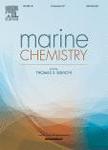版权所有:内蒙古大学图书馆 技术提供:维普资讯• 智图
内蒙古自治区呼和浩特市赛罕区大学西街235号 邮编: 010021

作者机构:Departamento de Química Facultad de Ciencias del Mar Universidad de Las Palmas de Gran Canaria 35017 Las Palmas de Gran Canaria Spain Accepted 21 July 1994.
出 版 物:《MARINE CHEMISTRY》 (海洋化学)
年 卷 期:1995年第48卷第3-4期
页 面:215-236页
核心收录:
学科分类:07[理学] 0707[理学-海洋科学] 0703[理学-化学]
摘 要:An overview is presented of the ability of phytoplankton to passively adsorb and actively assimilate heavy metals from their aqueous environment and to release into the environment organic ligands capable of complexing metals. The uptake of all necessary trace metals by phytoplankton occurs via binding to a surface ligand and subsequent transfer across the cell membrane. This sorptive process can be explained by using surface complex formation equilibria;due to the heterogeneity of the algal surface, multi-site binding models must be developed. The production of extracellular organic matter with metal complexing properties plays an important role in decreasing the concentration of free metal ions and thus mitigating the potential toxic effects on organisms. However, while much research has been carried out on the uptake of single species of metal ions, little attention seems to have been given to the study of multimetal ion systems. Synergistic and antagonistic interactions between multiple trace metals are expected and could be very important in the oceans. These types of behaviours are extremely complex, influencing uptake and release of natural ligands and limiting plankton production and plankton species composition in the oceans. Future investigations should be carried out in order to gain understanding how the combinations of metal ions affect the physiological, biochemical and ecological processes of phytoplankton in seawater.